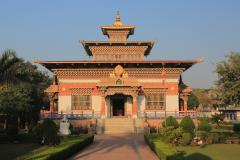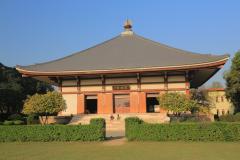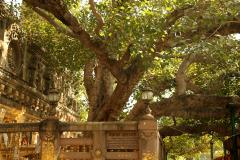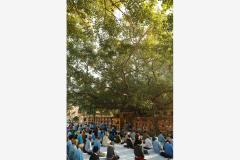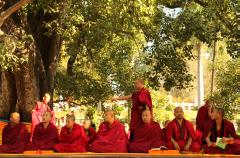Home of Buddha's enlightenment
Holiest of the holy Buddhist sites, Maha Bodhi Tree, across Asia in 2 hours and zazen sessions in Japanese temple
Bodhgaya is the most important Buddhist pilgrim town in the world. It’s right here that Siddhartha Gautama, under a specimen of Ficus religiosa tree, a.k.a. Maha Bodhi Tree, attained enlightenment and became the Buddha.
Thanks to its importance, every Buddhist nation built here a temple (sort of like in Sarnath, but there’s much more of them and they are much much bigger and nicer) so walking through the city, hmm, maybe more a village, by Indian standards, is like hoping onto The Orient Super Ultra Express and seeing the whole Asia in 2 hours: India, Sri Lanka, Nepal, Bhutan, China, Tibet, Taiwan, Japan, Korea, Bangladesh, Vietnam, Thailand, Burma. Some of the temples – Japanese (again, no surprise), Thai and Bhutanese (definitely the most beautiful one) – are really marvelous. I sleep in a room of Nepali temple, operated by family from Darjeeling – what a nice coincidence with my future travel plans.
As for the tree, there is an interesting story: I forgot to mention it in my post for Anuradhapura in Sri Lanka, but apart from being ancient capital of Sri Lanka, that city’s major sight was(Maha) Bodhi tree, the tree under which Buddha attained enlightenment and it was supposed to be the oldest documented tree in the world, because gardeners have taken constant care about it for more than 2300 years. But I knew that something smelled weird here, because I knew that Buddha attained Buddhahood in Bodhgaya in India, so how could it be possible that the tree was there in Sri Lanka? When we read Lonely Planet, it turned out, that the tree in Anuradhapura actually comes from a sapling of the original tree in Bodhgaya, so it was sort of replica (although as they used a sprout and not a seed, it was still the same living plant), but very holy replica. Back then in Sri Lanka I was looking forward to see the original tree in Bodhgaya. BUT, here’s the surprising plot: The tree in Anuradhapura is more original than the tree which grows now in Bodhgaya. In 3rd century BC, when Indian emperor Ashoka declared Buddhism as state religion (replacing Hindusim, but it didn’t last long…) and he spread Buddhism to Sri Lanka, he sent his daughter to Sri Lanka with that sapling of the Bodhi tree, where she planted it. Soon after that, Ashoka’s wife killed the original Bodhi tree in Bodhgaya. I haven’t found out yet why she did it, but I guess that she was either devoted Hindu, being pissed off by her husband’s replacement of Hinduism as the state religion by Buddhism, or her husband was not giving her enough of hot love as he was too busy with philosophy and Buddhism and so she got jealous and instead of cutting his dick she cut the tree. Either way, the tree in Sri Lanka is the first clone of the Bodhi tree, and the tree which now grows in Bodhgaya and which is smaller than the one in Sri Lanka, was planted from a sapling from that Sri Lanka trees. Got it? They replaced the original by planting replica from his replica :-) But, as I said before, it’s still the same living organism as the original one.
On 27-Feb-2013 I saw the tree. I have not attained instant enlightenment, but it’s definitely one of the most memorable days in my life – I saw, and sat under the tree (though replica of replica…) where Buddha attained enlightenment, 2 600 years ago.
Note for Samo and Janka: OK, you were right. That tree was The Tree. Congrats, you saw the right one!
Apart from international temples the city teems with monks, pilgrims and Tibetan refugees (Lonely Planet claims that even Dalai Lama often spends winters here). But best of all, there’s lots of places to meditate and I joined free zazen - Japanese Zen meditation – sessions in the Japanese temple. There are 2 of them daily: one from 5:00 till 7:00 in the morning and the other one from 17:00 till 20:00. It includes some chanting (pretty much limited to listening for non-Japanese, because Japanese chants are very long and very fast, so it’s impossible to follow, with few short exceptions) but it’s mostly just sitting in silence in meditation. Unlike Hindu meditation, zazen is with open eyes, and mudra - position of hands – is different. The best part of it is, that it is led by a Danish Buddhist monk who lives in Japan and at end of the evening sessions, he tells some stories and teachings. His words are true diamonds for me. What he says is interesting, wise and miles away from the backpacker chatter of “where are you from? for how long are you in India? etc.”. I sit there every evening in awe and listen, and I’m starting to feel sorry that I bought a flight to Australia in few weeks, because I feel like going to Japan when I listen to him. Dear Rev. Milo Finn, thank you for your wise words, I was desperately missing hearing something like this ever since I left the ashram!
Based on one of his stories I wrote down this note for myself in my paper notebook: the straight path is the shortest path, but only if it is the right path.
Bodhgaya is definitely nice and inspirational place to be – the atmosphere around the Maha Bodhi Tree is utterly relaxing - and I’m sorry that I’m leaving only after 4 days.
PS: The only thing which is really not cool about Bodhgaya is the amount of mosquitos. I have never ever seen such a mosquito infested place. I can imagine that Buddha did not get disturbed from his meditation by visions of creatures from hell and luring beautiful women, but I have no idea how he managed to ignore the mosquitos. They fly around in kilograms!
